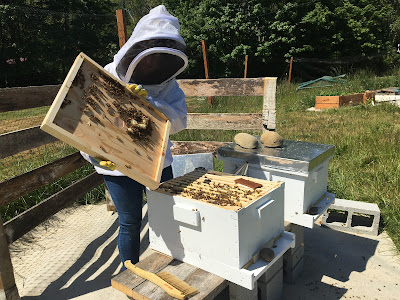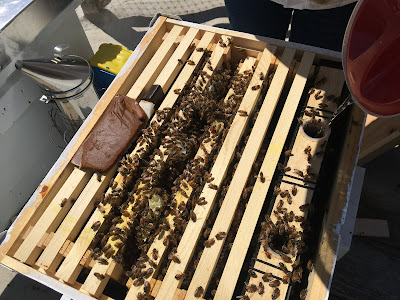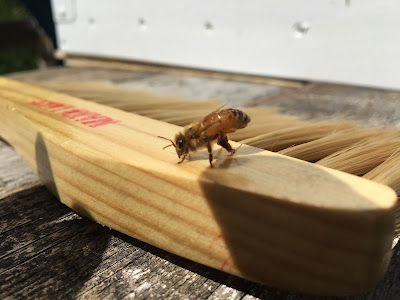Our honeybees need to be fed every 4-5 days. Since we have brand-new hives and our bees began their journey here without any honey already stored, they require sugar syrup made at a ratio of 1:1 (1 part sugar to 1 part water) this time of year. We've noticed that every 4-5 days, the gallon-sized feeder that's inside each hive has been nearly depleted. Eventually, as they build up their own stores of honey, they won't require as much or any extra sugar syrup during certain parts of the year after there has been plenty of nectar and pollen for them to forage.
Today I made more sugar syrup for them. The sugar syrup I'm making has 16 cups of water and 16 cups of sugar. Knowing how quickly we are going to be going through sugar, we have been purchasing 25-pound bags of sugar from Costco.
To remove any impurities in the water, we first bring the water to a boil in our big stock pot on the stove. After it boils a few minutes, I turn the burner off, add the sugar, and stir with a wooden cooking spoon.Bees don't like the cold. Before getting started, we make sure it's going to be warm out and we plan ahead to go out during the warmest part of the day. That's because we're going to be lifting the lid off the hive in order to access the interior feeder.
Moving slowly so as not to alarm the bees, the telescoping lid and inner cover are lifted off the hive and set aside. Now, syrup can be poured into the feeder. There are two holes in the feeder and a "stairway" of mesh plastic in there for bees to climb down. As soon as I begin pouring the syrup into the hole, the bees start climbing out as fast as they can. I pour really slowly so as not to drown any bees.We have been learning so much about bees. And there's so much more for us to learn! Nothing stays the same year-round and so there is the constant need to review what the next steps are. Part of the reason for this is because their requirements change depending on the weather and what is available to forage. For example, in the winter the sugar syrup will need to be made at a 2:1 ratio (2 parts sugar to 1 part water) or replaced with a solid sugar or fondant if temperatures dip below 50 degrees F. If they have stored honey, they can also eat that, and it is the healthiest option for them.
We've noticed that our Italian honey bees are very gentle and busy little creatures.












Comments
Post a Comment
Thank you so much for submitting a comment! All comments are reviewed by our moderator before being posted to the blog, in an effort to help control spam.